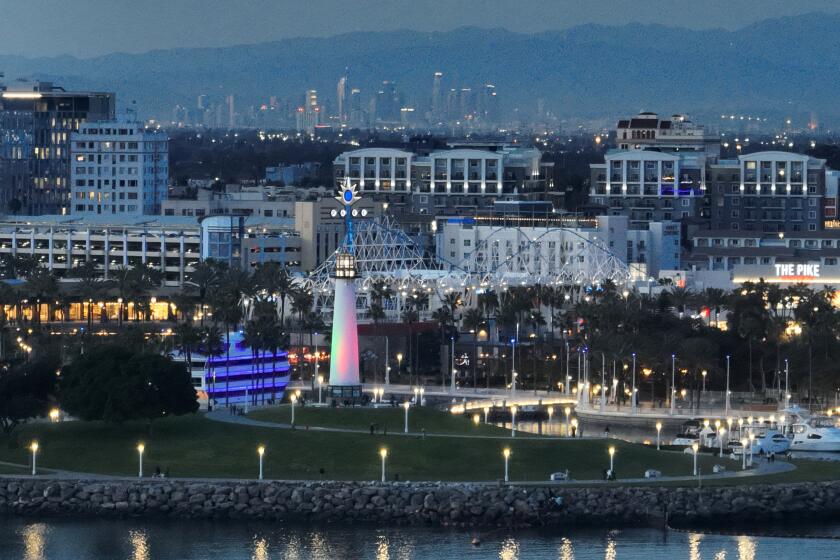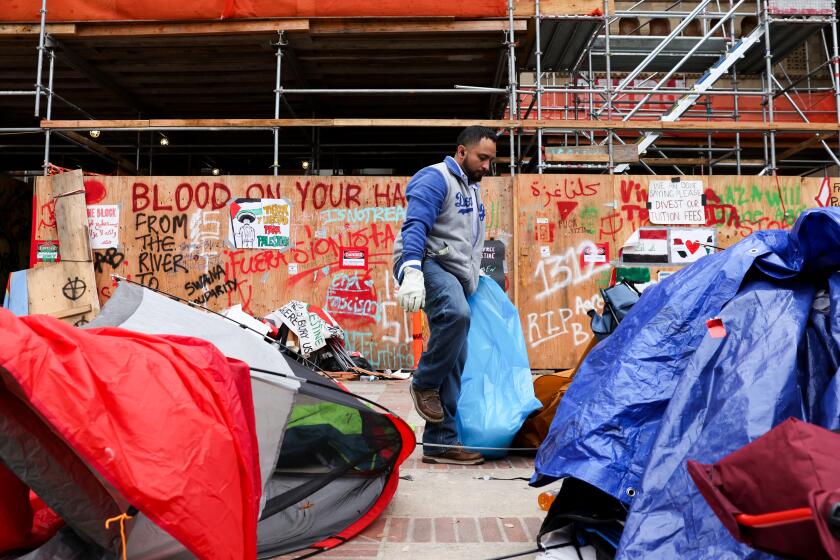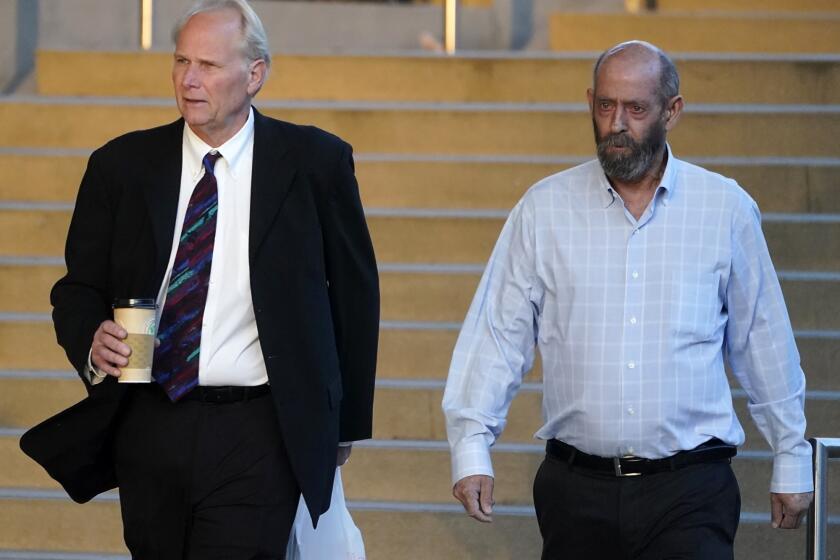The Place Once Called Home
When the news copters were hovering overhead and strangers were handing out $100 checks, it was easier for Lori Herek and her Bluebird Canyon neighbors to feel optimistic about recovering from Laguna Beach’s June 1 landslide.
More than five weeks later, though, reality is setting in. Mortgage payments are due on destroyed houses. American Red Cross assistance has run out. The welcome mat is wearing thin with friends who have provided temporary shelter. And federal or state aid is doubtful.
“Every day that goes by it’s becoming more and more nerve-racking,” said Herek, 49, who lost her Flamingo Road house. “We just don’t know what to do.”
With the initial shock of the disaster having receded, Bluebird Canyon residents are grappling with long-term challenges.
At first, “there’s a lot of spontaneous reaching out, heroism and a palpable sense of community and caring,” said Frank Ochberg, a Michigan State University psychiatry professor who has studied disaster aftermaths.
But once that initial outpouring of public sympathy and media attention evaporates, victims face financial struggles, feuds and other problems that can drag on for years.
Bluebird Canyon residents are dealing with post-landslide life in a range of ways -- from angry activism to Zen-like poise. For many, the largest hurdle is avoiding financial ruin.
“How do you pay the mortgage on a house that no longer exists, pay rent on a temporary residence and save to build a new home without getting any government aid?” asked Diane Stevens, standing outside her family’s shattered Flamingo Road cottage. “Why is this natural disaster any different from the floods, hurricanes, tornados and earthquakes for which there exists a safety net?”
The Federal Emergency Management Agency used to pick up the tab for restoring slopes after landslides, but stopped a few years ago because of high costs and questions about the wisdom of rebuilding in such unstable areas. Insurance policies that cover landslide damage are rare.
“It sounds really bad, but I wish it had been a fire instead. Then we’d be insured -- and insurance would be paying for a place for us to live and to rebuild a home,” said Tripp Meister, whose Bluebird Canyon Drive house was partially crushed.
City officials have pledged to rebuild the hillside and are exploring ways to finance the project. They also have asked FEMA to piggyback the slide onto disaster declarations from February’s severe rainstorms. That would bring in federal and state money for repairing streets and utilities, and allow residents to apply for low-cost reconstruction loans.
In the days after the slide, local merchants and churches donated meals, hotel rooms and clothing to displaced residents. And citizens rallied to the cause with a breakfast fundraiser and other contributions.
“It’s like when someone close to you dies and everybody shows up with a casserole,” Stevens said. But, eventually, the good Samaritans move on and survivors are left to fend for themselves.
Stevens and some neighbors are campaigning to keep Bluebird Canyon in the public eye by lobbying government officials and pushing for continued media coverage. “We don’t want to be forgotten,” she said. “We desperately need help.”
Not everyone believes they deserve it.
“There are some places people shouldn’t live,” said geologist Dee Trent, who co-wrote a textbook on the subject. “Some look at a home on a cliff and think ‘Beautiful views.’ I look at it and think ‘Landslides.’ ”
Of course, by that standard, large parts of Southern California could be considered off-limits to homebuilding, given the risk of quakes, wildfires and floods.
“There aren’t too many places in this area that Mother Nature can’t get you,” said Mike McCoy, whose San Clemente house was wiped out in a 1980 landslide.
Another reason some outsiders are skeptical about bailing out Bluebird Canyon is a perception that homeowners there are so wealthy that they can financially withstand the disaster.
Not true, Stevens said. Many slide victims, including her family, moved to the picturesque enclave before real estate prices skyrocketed. Before the slide, their homes were valued in the multiple millions, but “now that asset is gone,” she said.
Meister, a former Microsoft program manager, quit his job last year so he could take care of his two young children while his wife, Laurel, a painter who worked from home, focused on her art. The money they had set aside for Laurel’s art career wasn’t meant to pay for rebuilding a house, he said.
Meister, 34, is contemplating returning to work. “I don’t want to,” he said. “This is our dream and I hate to give it up. But I might have to.”
Still, Meister’s family is more fortunate than other victims. Their home is damaged but repairable. And, by a stroke of luck, a stranger who wanted to help slide victims is letting them live rent-free in a vacant Corona del Mar home for the next five months or so.
“I have a space, a place to call home even though it’s not mine,” Meister said. “I think that’s what keeps me and Laurel from going truly insane.”
Robert Power, 71, also feels lucky. “My mortgage is paid off,” he said. “I just have to worry about paying rent and getting enough money to rebuild.”
Now ensconced in a Dana Point apartment cluttered with furniture and other belongings rescued from his bulldozed Bluebird Canyon Drive house, Power appears to be taking the disaster in stride.
“Am I going to cry about a house that’s gone?” he said. “I can’t imagine sitting around dreaming about what was and what won’t ever be again.... I call this a new journey. We got out of that rut we were in and get to start over again.”
But the path can be a nightmare, McCoy said, recalling the aftermath of San Clemente’s 1980 slide. “Everything starts out great -- until the money starts having to come out of people’s pockets. Then people’s character changes.... These disasters bring out the best in people and, unfortunately, sometimes the worst.”
The recovery process is all-consuming. “The shine has worn off the story for journalists,” Stevens said, “but it’s still the big story in our lives every day.”
For Dale Ghere, who lost his home in the 1978 Bluebird Canyon landslide, a decade passed before he could wake up on the anniversary of the slide and not think or talk about the disaster all day.
“For the first 10 years, every event is identified as either before the slide or after the slide,” he said.
Ghere’s kids also had difficulty adjusting. Three weeks after the 1978 slide, his 12-year-old son, Ryan, came home with a note from his teacher saying he was not completing assignments or paying attention in class.
Ghere was not upset. “I told him it’s true for me at work too,” he recalled. He said to Ryan, “If it’s the same a year from now, we’ll talk more about it. The teacher doesn’t really understand what’s happening in your life right now.”
Not every disaster side effect is negative.
More than five weeks after Laguna’s landslide, Stevens is noting some unexpected benefits.
Trudging around the dusty wreckage of Flamingo Road this week, she explained: “You’re in such awe that people got out alive that the destruction is almost secondary.
“You develop a greater appreciation for everything,” she added. “You hear the same thing from people who’ve overcome cancer. Sometimes they say they’re glad they were sick. I never used to understand what they meant. But when you go through something like this, it does change you.”
*
Times staff writer Kimi Yoshino contributed to this report.
More to Read
Start your day right
Sign up for Essential California for news, features and recommendations from the L.A. Times and beyond in your inbox six days a week.
You may occasionally receive promotional content from the Los Angeles Times.






